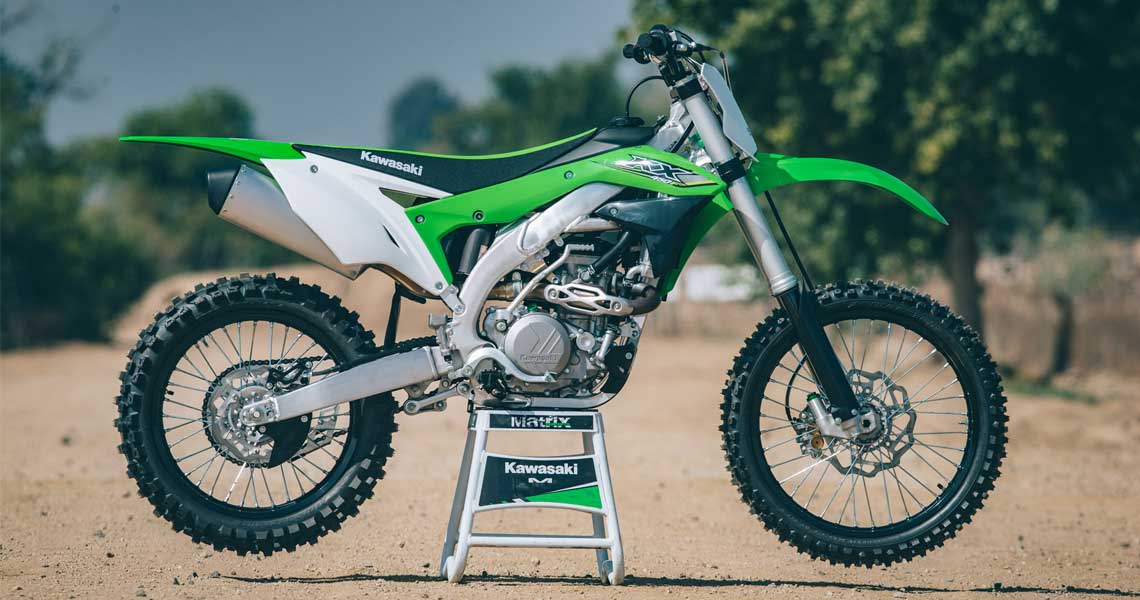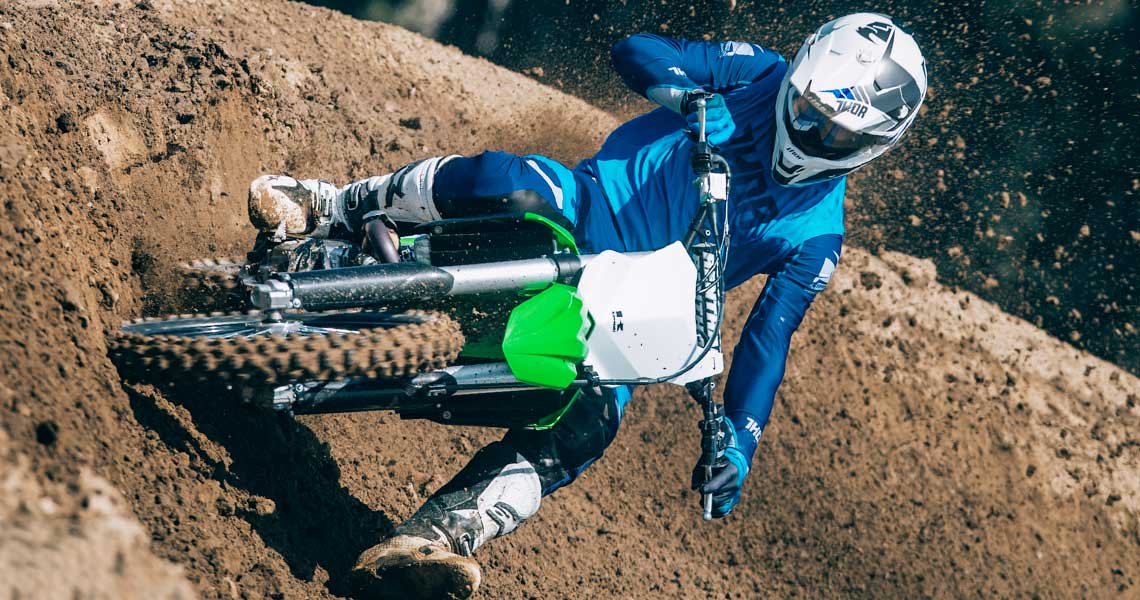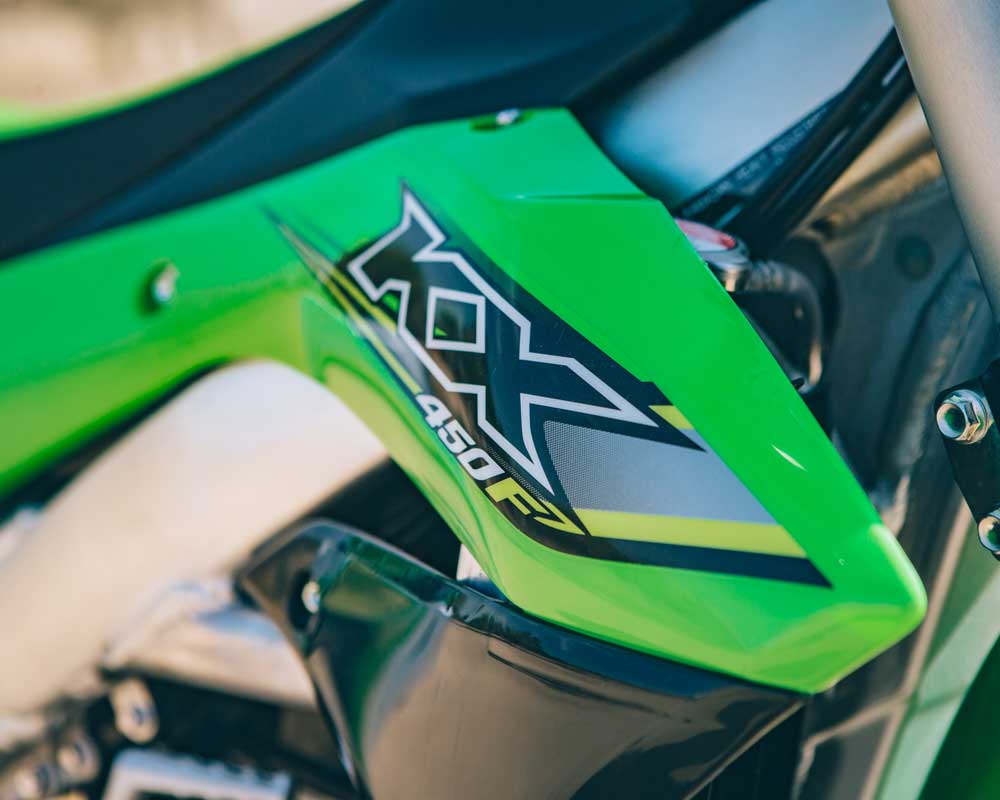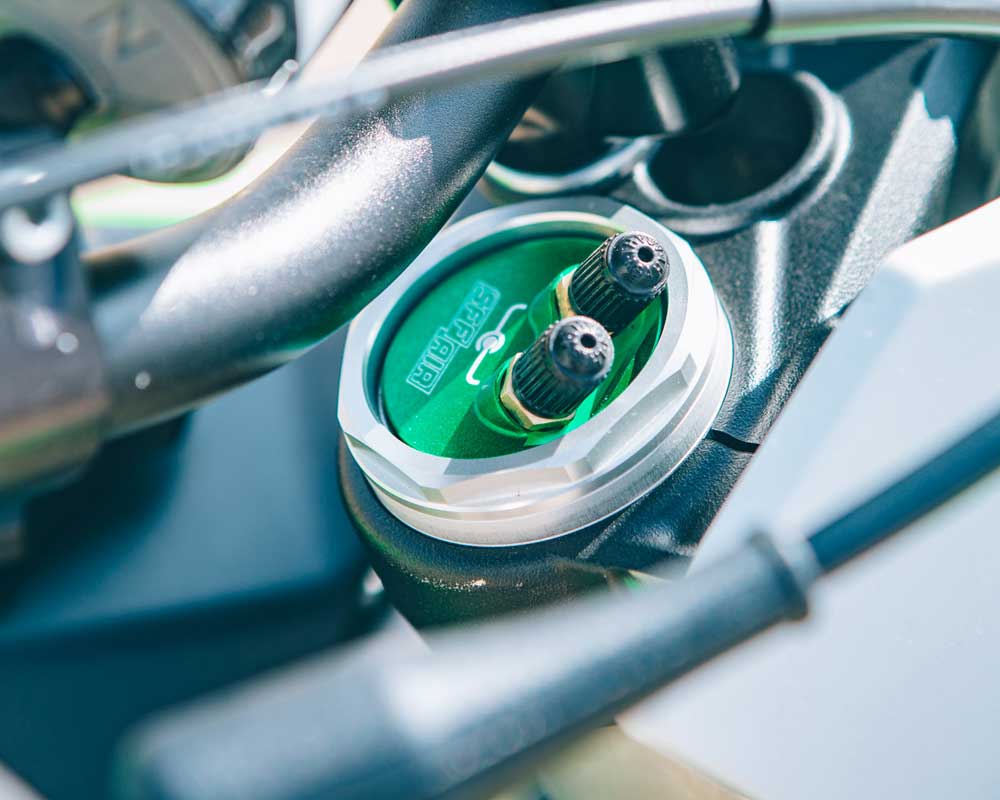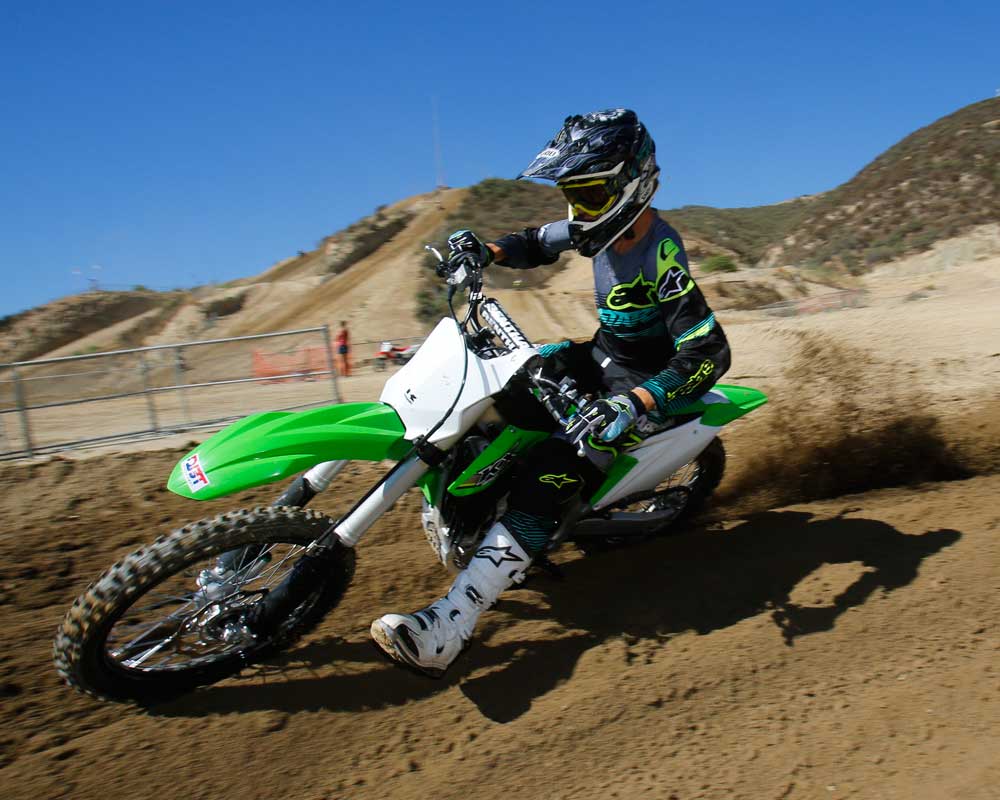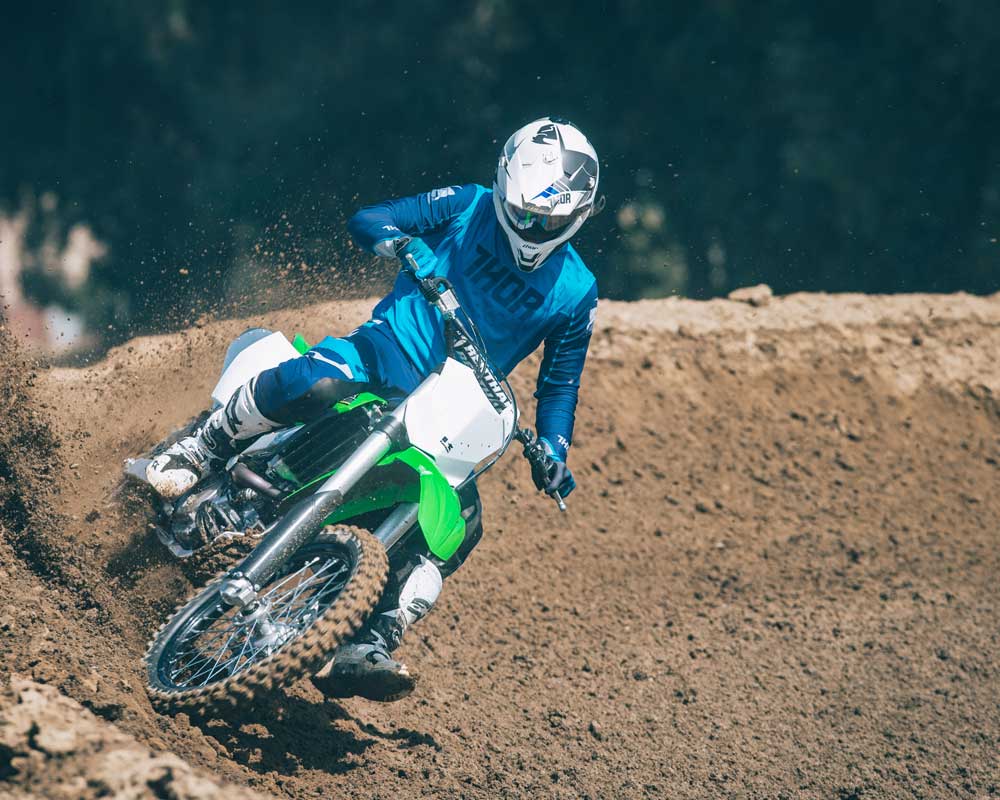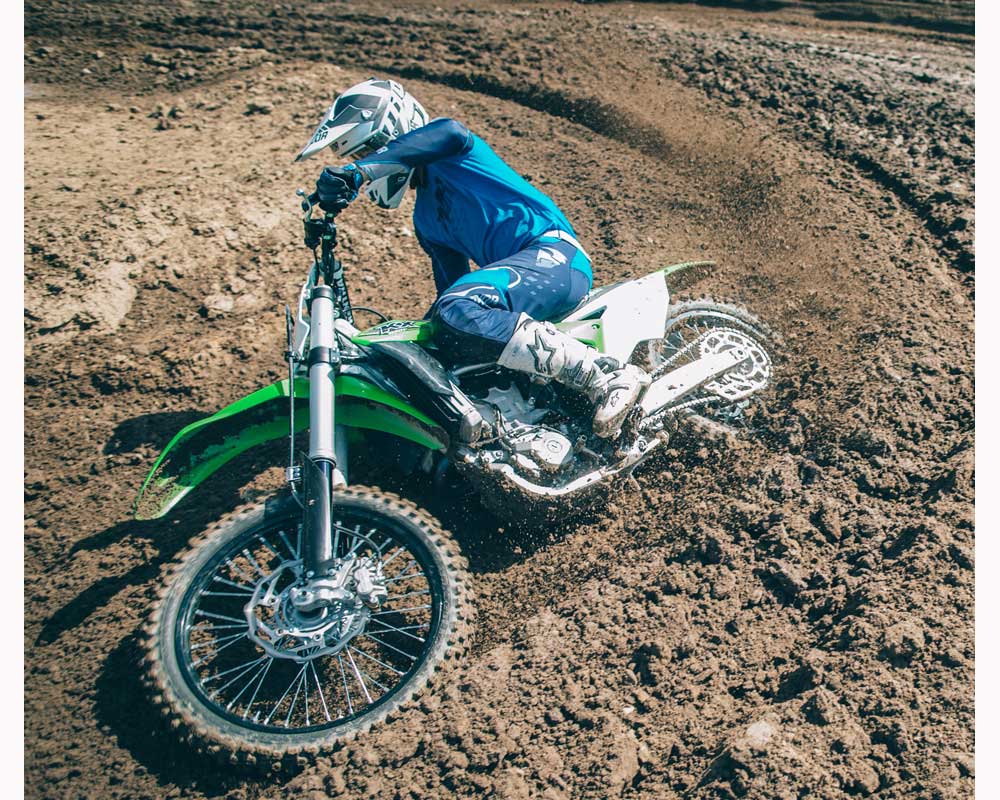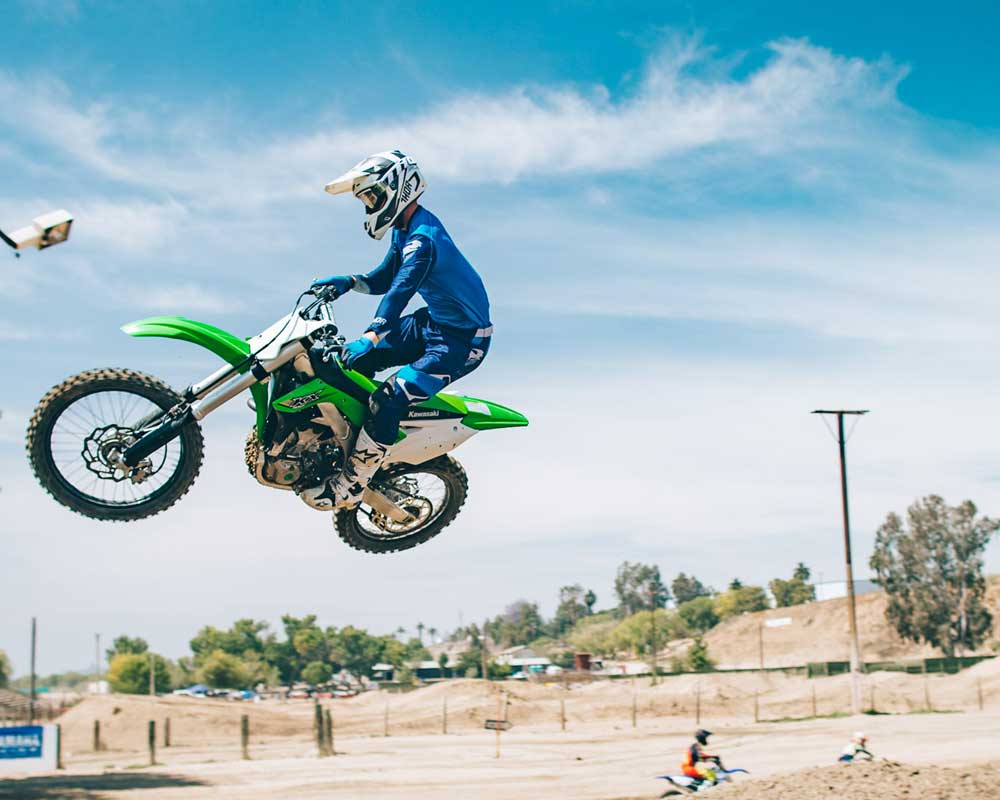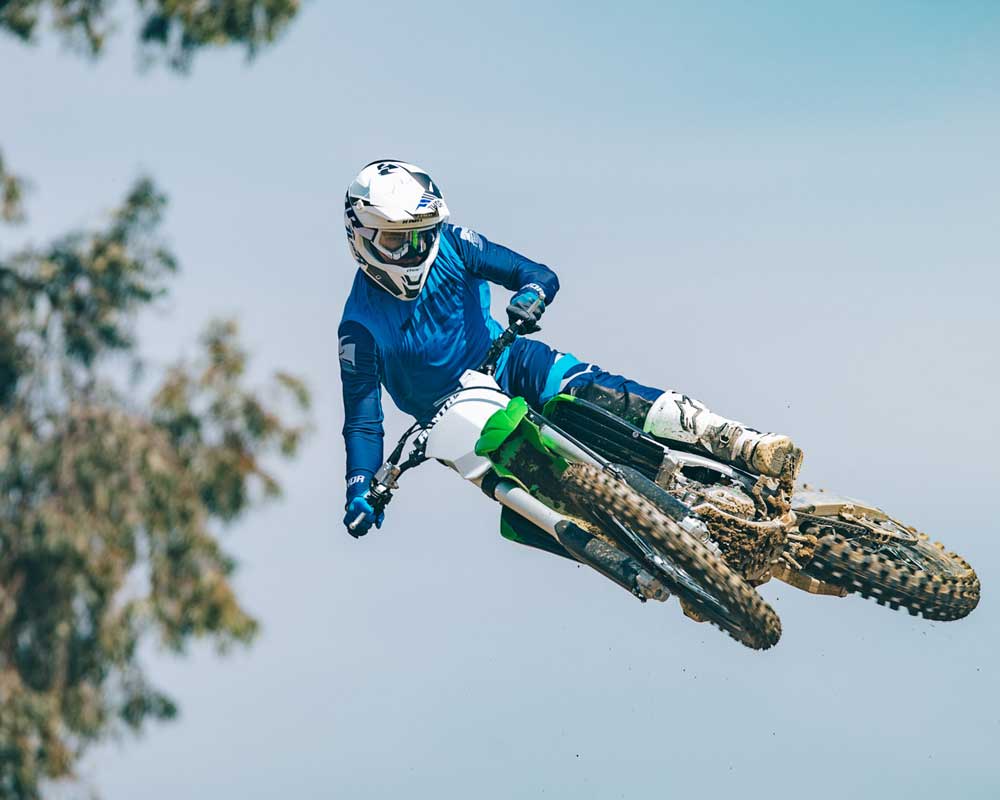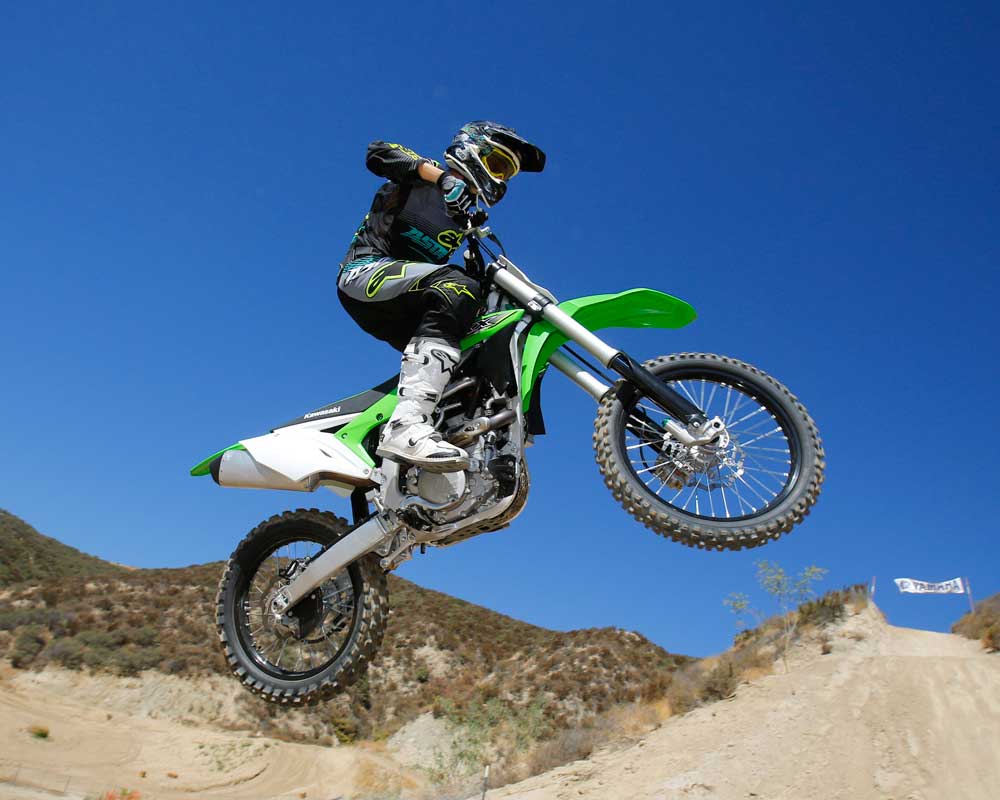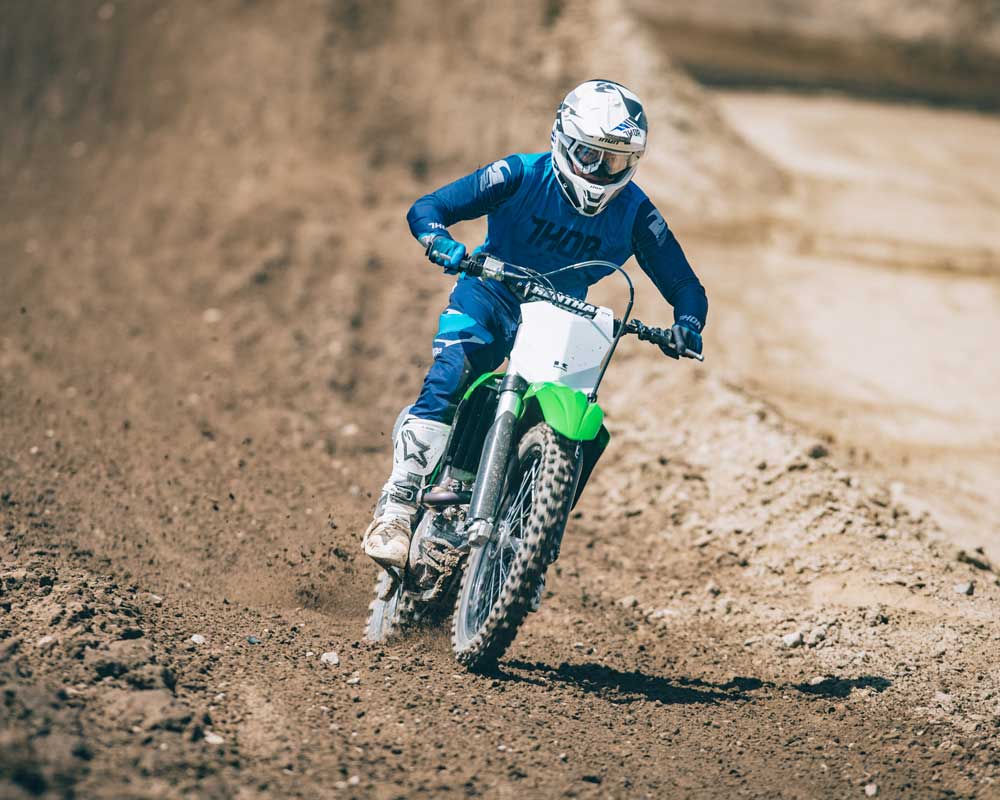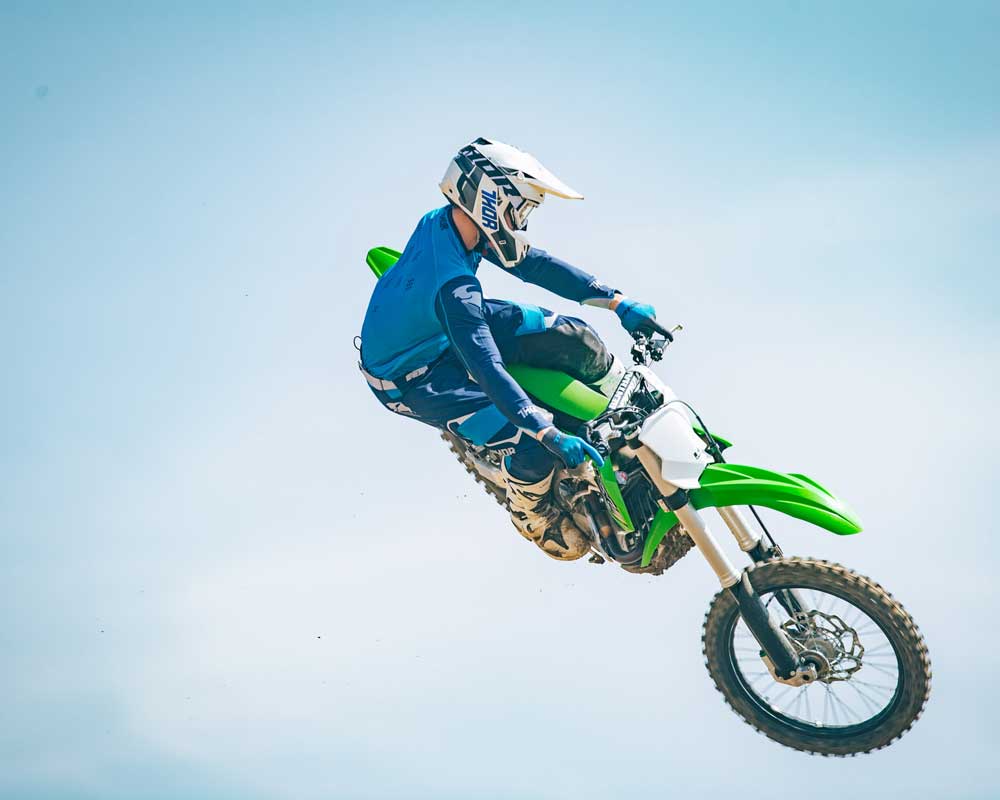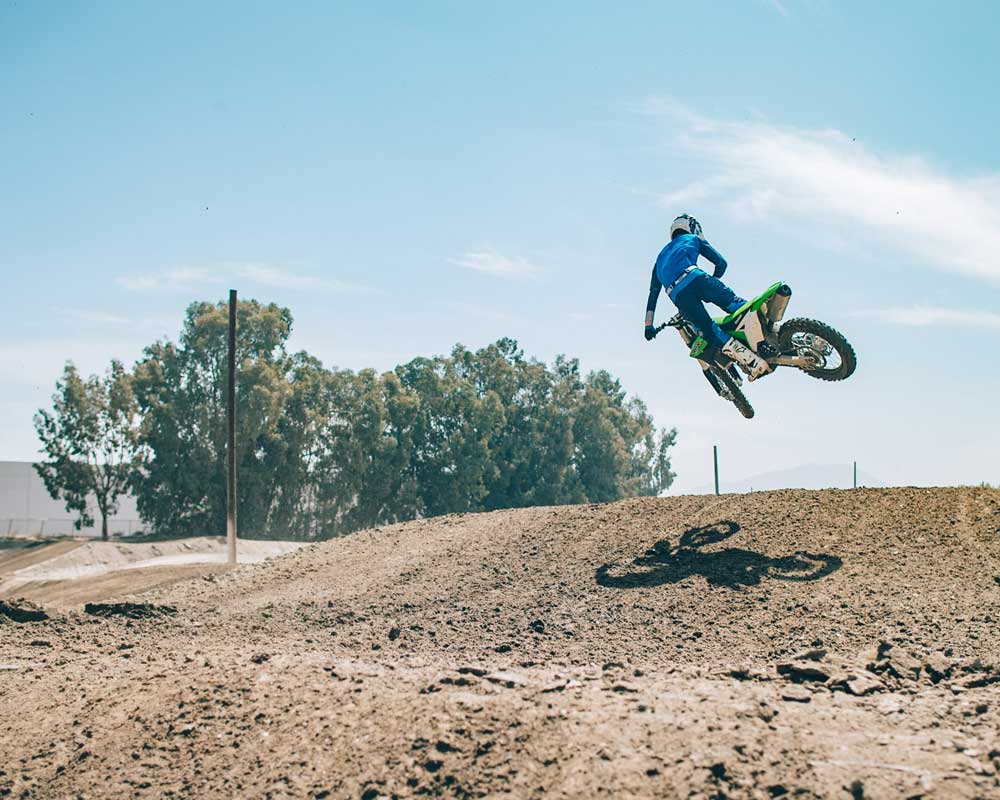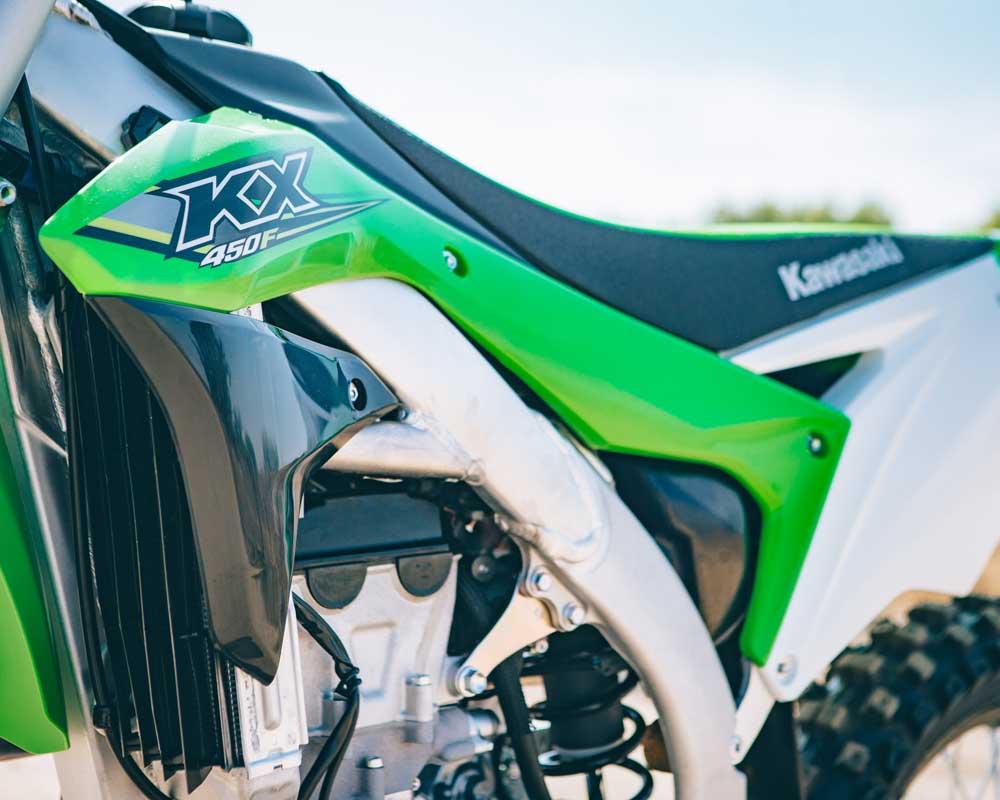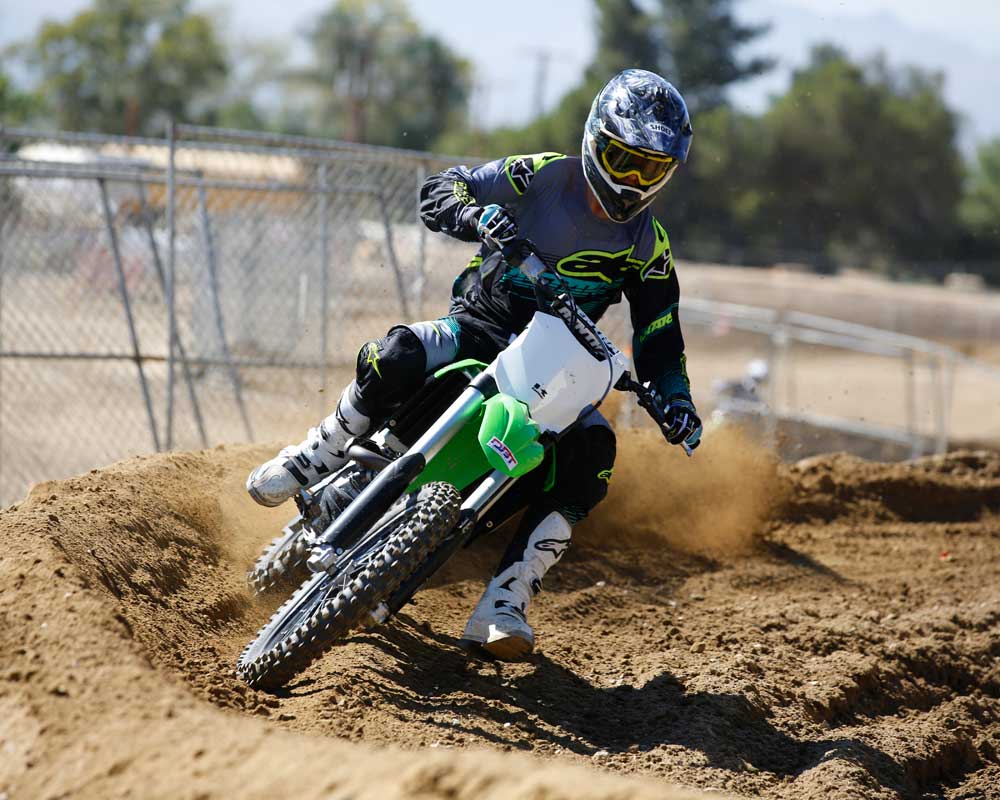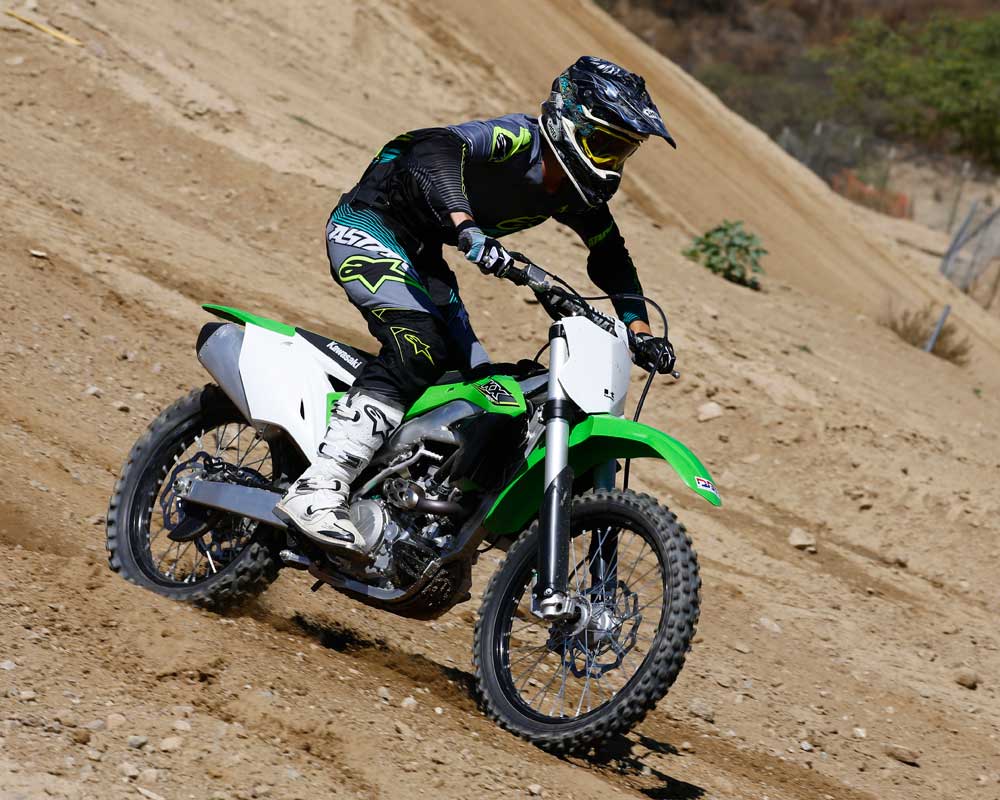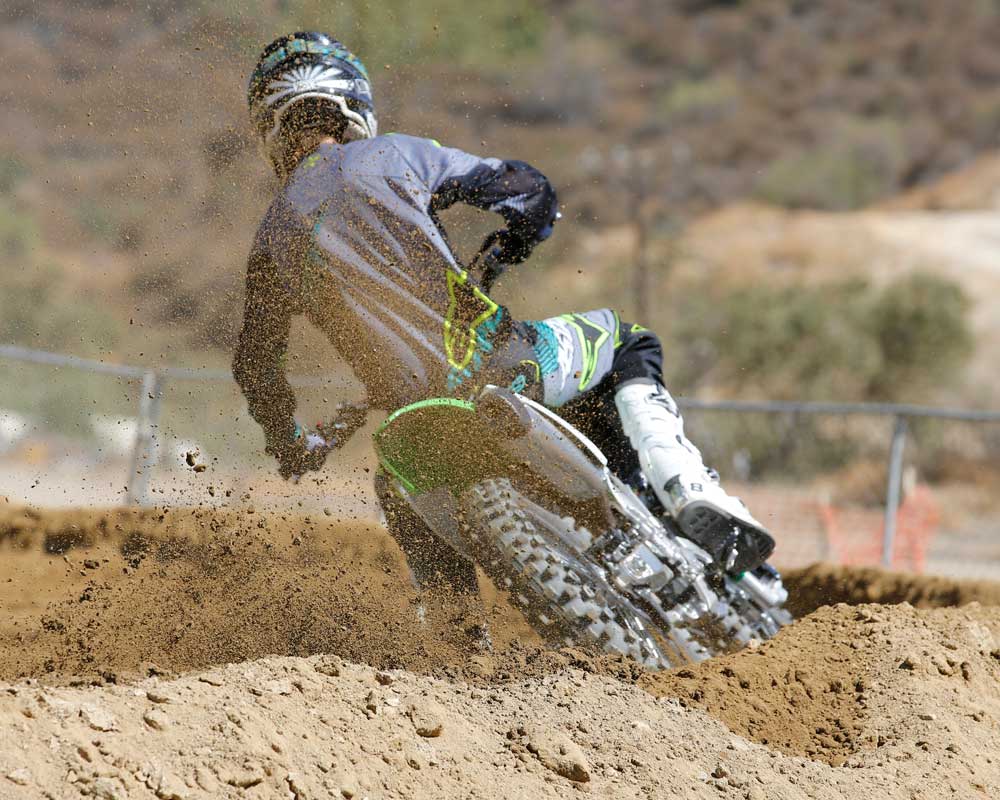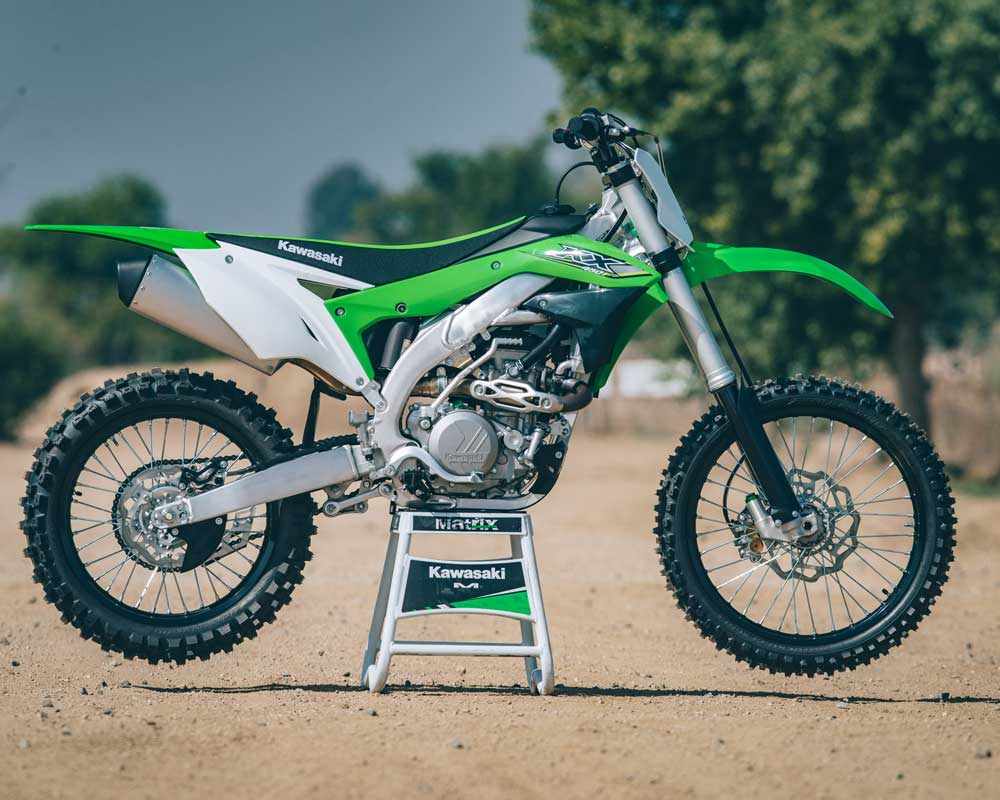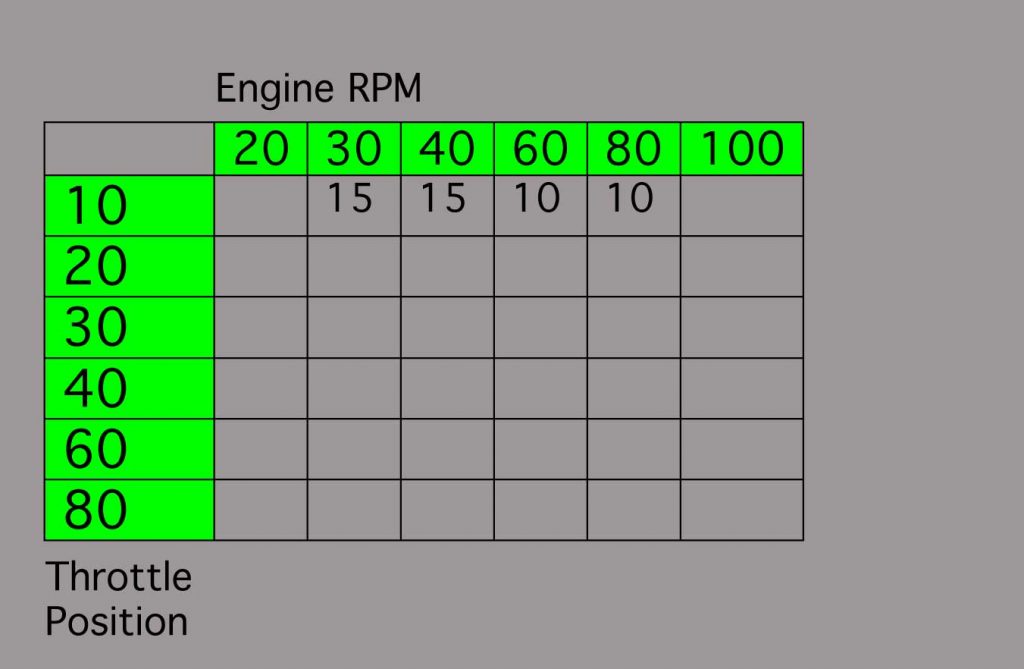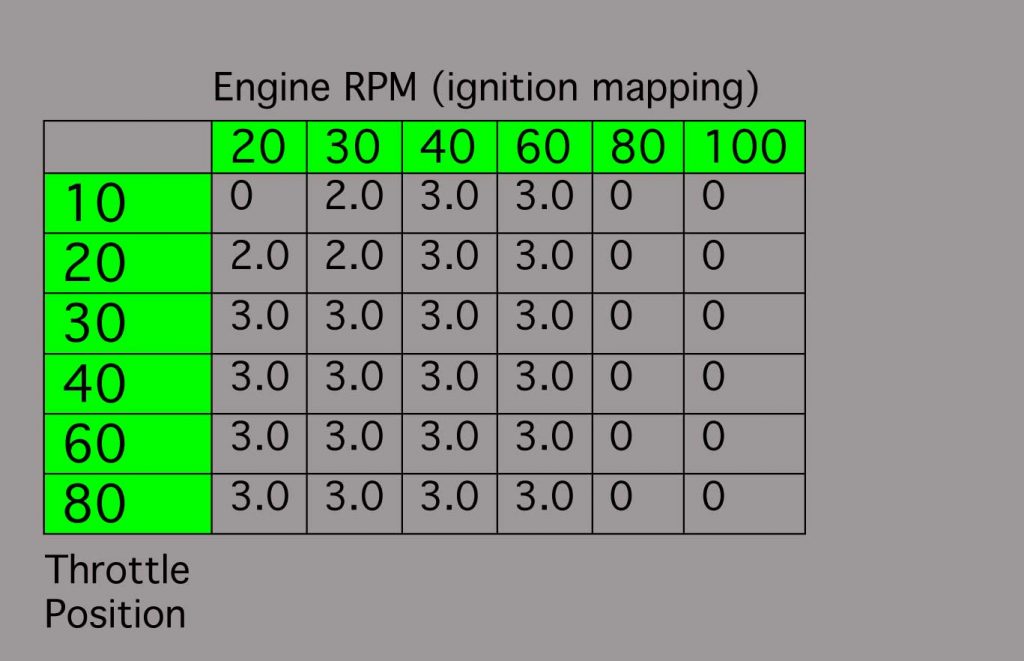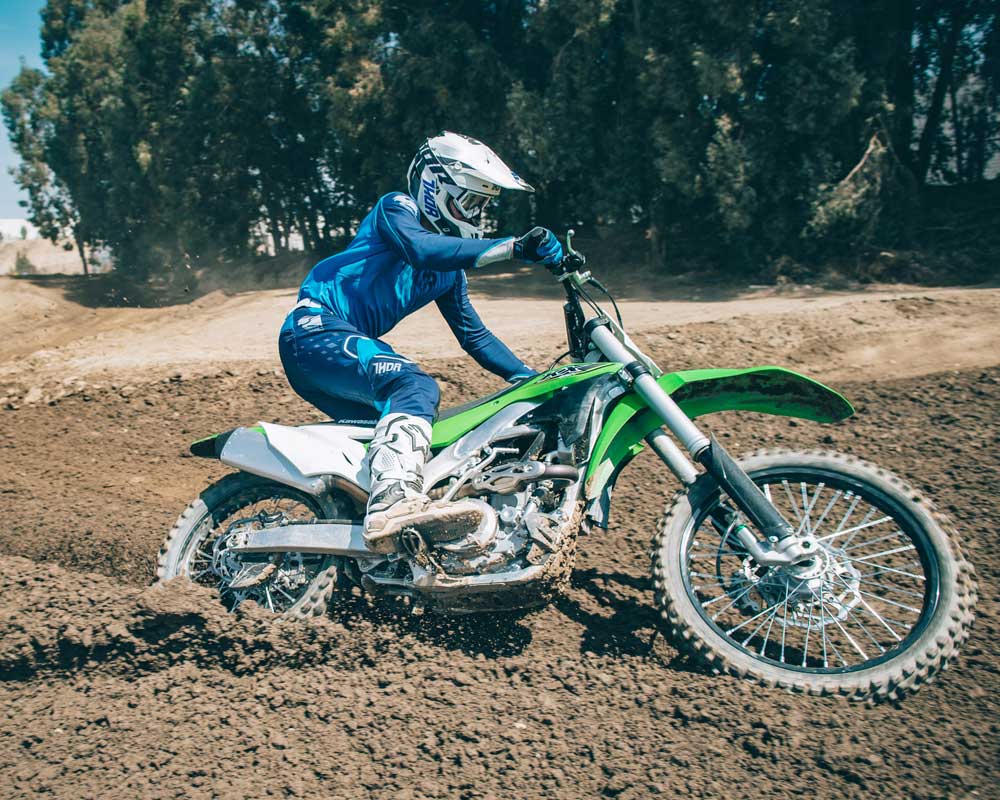2017 Kawasaki KX450F Full Test:
Updates With Just Enough To Keep It Great
MSRP: $8849.00
- Chassis that seems to appeal to a wide variety of riders.
- Solid power that is very tunable with the Kawasaki FI Calibration computer.
- The subtle changes to the chassis and the suspension are very welcomed and make the 17 a slightly better bike over 2016.
- Front rim was a little out of round by the 10-hour mark of testing.
- Wish the front end was more planted in some turning conditions
- Some test riders wanted more tractable torque and pull exiting corners
Introduction
- The 2016 KX450F isa great bike, the subtle changes to the 17 make it slightly better
Kawasaki has accomplished a lot by not overdoing innovation and changing what already works. Yes they built a lighter and slimmer KX450F in 2016, but they didn’t take too many risks with the overall chassis characteristic. Being the lightest and smallest is not always a proven winner, while having solid handling, the right power, yet maybe not the most power, can be a very potent concoction for a winning motorcycle. With a solid base, there is only a small list of changes to the 2017 KX450F. The KX already appealed to a broad crowd and was a favorite to many, maybe only small changes were necessary?
Changes
- Updated fork valving and a stiffer triple clamp lead the list of 2017 updates
- A more progressive rear link and reconfigured singarm out back are both new for 2017
Kawasaki did what they had to do in 2016 by slimming down the KX450F in all of the right places, updated suspension components, and worked on some of the front-end turning issues picky riders had concerns with. They also lightened the bike up by seven pounds in ’16 and restyled the overall look. For 2017 the KX is very much the same ride but there are subtle changes to elevate the already proven machine. The top triple clamp has been stiffened up, front fork valving revised, and the linkage now has a more progressive ratio. The link changes also prompted the cross member of the swingarm to be altered to create more clearance between the shock and the swingarm. The added clearance also helps keep rocks and dirt from lodging into this tight space and potentially causing issues. On the engine side, there was a slight ECU mapping change to help improve popping on deceleration. The graphics are also now molded into the shrouds for lasting durability.
Even though the 2016 had some minor rider complaints with fuel mapping, a fork that blew through the stroke at times, was not always the best turning machine in the class, it was still a mount that a slew of riders picked as their favorite for the year. The issues were minor, but overall the KX450F package has been among the top dogs in the class year after year because it gets the job done and appeals to such a diverse group of riders.
Power
- Very User friendly engine that produced very ample and very usable performance.
- Tuning via Kawasaki's modular ECU computer, but at a $699 cost.
There was a time when the KX was a hard-hitting burly machine. The latest versions are easier to ride but are not as potent feeling as in the past. We’re not saying this is a bad thing, just different. The '17 KX450F is fast, deceptively smooth and appeals to a wide variety of riders and because it offers three different mode couplers, altering the performance is very easy and quick. And we discovered if you have the Kawasaki handheld FI Calibration kit computer ($699.95), the sky’s the limit with regard to tuning. And while testing the 2016, we learned the KX450F responds very well to some aftermarket exhausts. (http://dirtbiketest.com/product-tests/fmf-4-1-rct-system-for-kx450f/)
In stock trim, most of our test riders were happy with the power delivery. Down low, the bottom end is smooth but might be lacking a tad bit of tractable bite when launching out of corners. The engine comes alive in the mid but not too harsh or abrupt and pulls pretty well into the top. Again, the delivery is very rider-friendly, not slow feeling, and works very well on a variety of tracks. Tuning with the FI Calibration is very useful and most riders were able to move the power around to fine-tune what they like best.
Early in our 2017 KX test we also learned that having fresh fuel is very important. We had some detonation issues on a very hot day at Glen Helen and we believe it was a mix of older fuel, very hot weather, and a hot engine. Later during testing we rarely had the issue unless the bike was under an extreme load in the lower RPM range.
Our 200-lb rider’s opinion, that being me, differed from some of the lighter test riders on the KX450F with regard to performance tuning. I felt like I had to make more aggressive alterations from stock to the ignition timing mapping (advancing it from the ¼ to just past the ½ sector of the grid across the rpm range). I like an engine that hits a little harder in the mid and I felt like it did not launch out of corners hard enough before I clicked to third. I was forced to take off on some jumps high in the rpm range in second because there was not enough pull or rpm built if shifted into third. Faster riders that carry more speed through the corners and weigh less did not have the same issues.
We had the most luck with advancing the ignition over adding or removing fuel. Yes this did help improve the performance but from there I still felt like I wanted to carry some faster corners in third and the engine did not pull well enough out of the hole during those situations. To move the power around we altered the gearing by adding a tooth to the rear sprocket. This helped the issues for sure. The KX launched out of tight corners harder and the transition to third kept the engine rpm higher and the bike pulling harder into and up jump faces. I was able to use third in way more corners and shifted less on most tracks we tested on. There were a few areas that the gearing change was almost too much, but overall for this 200-lb rider it made the bike easier to ride and further helped calm down the chassis due to riding in the higher gear.
This just goes to show how versatile the KX450F is, a group of four different test riders at different skill levels and weights were able to tune the KX to their liking without having to reach out to the aftermarket world. The couplers make some serious changed but the tuner is magic...at a price that rivals an exhaust system.
Suspension
- The new for valving is an improvement over 2016
- The Showa TAC fork can be complicated to tune at times because there are so many combinations.
Having a solid fork can ultimately make or break a motocross bike. At least that has been the case in the air fork age. The Kawasaki comes with the SFF Showa TAC fork, originally released on the KX in 2015. We have had pretty good luck with the triple-chamber fork but it can be complicated to tune since there are so many options to alter the way this fork works with air pressures as well as clickers. The ’16 KX450F was a new motorcycle and the fork also came with new settings. Finding the balance between small bump compliance, bottoming, and a fork that holds itself up in the mid-stroke is always a game. The ’16 fork offered good bottoming control for a single hit such as overjumping or coming up short—meaning a fast impact. Yet this fork liked to blow through the stroke and sometimes bottom on transitional impacts such as landing into the whoop or abrupt small jump faces. You were able to tune some of this out but then the fork tended to be harsh in chop or small bumps.
For 2017, Kawasaki addressed this issue and made some headway. Some test riders were able to get the fork to work very well with almost standard settings and/or slightly more air pressure over stock. The pressures are very much different when comparing it to the 2016. First off the Schrader valves on the top of the fork have been swapped. The inner valve is now the outer chamber and the outer valve is now the inner chamber. Standard settings are 152 for the inner chamber, 16.7 for the outer, and 174 for the balance or lower chamber. Compared to 2016, the inner chamber pressures have been decreased but the outer chamber has been increased.
Even from our early ’17 testing we started to work with higher air pressures, very close with Kawasaki’s “hard settings” compared to “standard.” The new settings and valving for sure changed how the ’17 fork works and did help firm up the mid-speed, blow-through issues. Some of our riders liked the new feel but on jump-filled tracks there were some bottoming issues on big landings or a slight slap-down feeling when landing slightly rear wheel first. Small pressure increases to the outer chamber helped but it also starts to make the fork feel busy in small chop and in breaking bumps. Backing out on the compression soaked up the chop better, but more than a few clicks and you could start to feel the fork ride too low in the stroke and feel mushy. There is such an interesting balance and crossover when trying to set up the TAC fork. Finding that balance—when to adjust air or just clickers—can be a dance. We also found that slowing down the rebound on the fork and shock helped settle the bike down from becoming too busy in some braking situations including downhills.
With the higher pressures, small changes (increases) to the balance chamber helped the front feel more plush in the chop and relieve some of the slapdown sting on some landings. Our 200-lb rider went a step further without having to keep increasing pressures by going old school and added 10cc of oil to the right fork’s dampening leg. We added the oil to the outer chamber. Using the standard air bleed screw with a syringe makes it an easy task. The added oil helped firm up the fork at the bottom of the stroke on the dampening side and allowed us to soften up the compression clicks a few clicks and fine tune air settings. This helped heavier riders find that balance of good bottoming control with a fork that holds up in the mid-speed without feeling harsh on the chop and breaking bumps. It took several days of testing but our 200-lb rider was able to find a setting he liked and a balance between small bumps and harsh big landings. Keeping track of your settings is very important until you find what you are looking for.
Except for some shock preload settings, depending on rider preference and some slight clicker changes, the shock was pretty much left alone. Sag was always set in the ballpark between 104-105mm. Some riders did alter some rebound settings depending on the track and minor compression settings, but nothing more than a few clicks either way. The shock tracks very well in most conditions and keeps the rear wheel tracking well even under a load. There were a few rear kicking issues but they were often track condition related and there were a few situations in long, deep, slower-speed whoops that our heavier riders felt the rear go through the stroke a little fast, bottom, and bounce off the rubber bumper. You could feel the rear step out a little in these situations and tuning for just these obstacles gave up too much of the overall solid feel of the shock. Slight 1/8 adjustments inward to the high-speed compression is suggested during testing to understand how it affects the rear and the balance including the front end. Going to a stiffer shock spring would be our next step to test for riders around or over 200lbs.
Chassis - Handling
The KX has never been a carving tool but they have made forward advances over the last few years. Even with the minor changes to the fork clamp and the rear link, you can feel a slight difference. The KX does not necessarily rail corners like some other bikes and still prefers some of the control be dictated slightly by the rear wheel and the throttle. The chassis is still one of the most tunable motorcycles with its four-way handlebar positions and the ability to lower the foot pegs. With the changes from 2016, most of our test riders ended up sticking with the stock settings. Only our 6’3" rider did prefer moving the handlebar to the forward position. The chassis of the KX caters to such a wide variety of riders. It does not feel ultra light like a KTM 350 but it also doesn’t feel heavy either. The chassis is very balanced and stable at speed but also turns better than older generation KX450Fs and even slightly better than the 2016. Being smooth on the throttle is very important on the KX. In a berm or on flat, the chassis works better if the rider is not too aggressive and doesn’t upset the chassis while exiting corners. It might not always feel fast but being smooth is actually faster on the KX.
The KX does feel best if it can find a berm or something to apex off of but does work on the flat. Especially if the rider is not too aggressive with the throttle but just enough to keep the rear wheel tracking with maybe a slight slide. We did have a few issues with losing front wheel bite while entering corners and if the conditions were slightly wet or dry on flat corners. The stock Bridgestone tires might have been some of the issue and we realized air pressure is very important. The 403/404 combo seemed to work best between 12 and 12.5 pounds. The only problem is if you like the stock Bridgestone tires, they no longer offer that tire to the public. Bridgestone has since replaced the 403/404 but Kawasaki probably did all of there testing before the switch.
What’s the appeal of the KX handling? It’s stable not twitchy, comfortable, and doesn’t do anything bad. It’s a motorcycle that most riders can jump on and adapt very quickly and feel comfortable.
Conclusion
- The 2017 KX450F is a solid machine with manageable power, roomy ergos and workable suspension for the masses
Because there were only slight changes to the KX (all in the right direction according to us), the Kawasaki is on the right track for 2017. They had a great bike in 2016 and now it’s slightly refined. The KX450F is the everyman’s motocross bike. It seems to draw the attention of a broad group of riders of all speeds and even weights, and doesn’t really have any real bad traits. The power is solid and very tunable, as is the suspension, even with a complicated fork. Almost every rider that jumped on the bike felt very comfortable in a matter of laps, even if it was not specifically tuned for them.
We logged in 12 hours on the 2017 KX450F at the time of the test and the bike is holding up well considering. The rims have always been an issue on most production motocross bikes from Japan these days. Our front rim developed some flat spots and slight shimmy along the way. We checked and adjusted the spokes before every ride but it didn't make much of a difference, it still got bent up a tad and some of the spoke nipples rounded after several adjustments. It still cleans up well with a good spit shine but the plastic is scratched and it looks like it has been a little more wear than the hour meter indicates. We did have a few cases of hitting false neutrals and we think it has to do with some of the oils we were running. If you have any issues, try changing oils first. The above are the only real issues at this point, everything else, even the chain and sprocket and chain guide are still intact.
There is a reason the KX has been one of the most-liked 450s over the last few years. But like all of us, the one bike for 2017 we are all waiting to ride is the new Honda CRF450R. Right now the ’17 KX450F can go shoulder to shoulder with any 450 and to some it is the better motorcycle. The KX450F is not perfect, but as an entire package it is a very good motorcycle for a broad group of riders. It is always difficult to pick out specific traits that makes the KX appealing, it's when you get the bike working well it just works well, doesn't do anything funky and is fun motorcycle to ride.
Scott Hoffman Settings:
Height: 6'1
Weight: 200lb
Ability: Vet Intermediate
All clickers are counted out from being closed
Fork:
Inner Air Pressure: 167-170
Outter Air Pressure: 17-18.5
Balance Chamber (lower): 180-190
Compression: 6-8
Rebound: 10-11
Fork Oil: Added 10cc to out outer right leg
Fork Height: Stock
Shock:
Preload: 104-105mm
Compression:12-14
High Speed Compression: 1 7/8 - 2
Rebound: 14-15
Rebound:
High Speed Compression:
Ignition Timing: Per Kawasaki FI Calibration Kit
*Note: The actual chart does look different but the grids do represent the same settings
*Note: The above settings are what we tested and posted as a reference only!
Recent Product Tests
Leave a Reply
